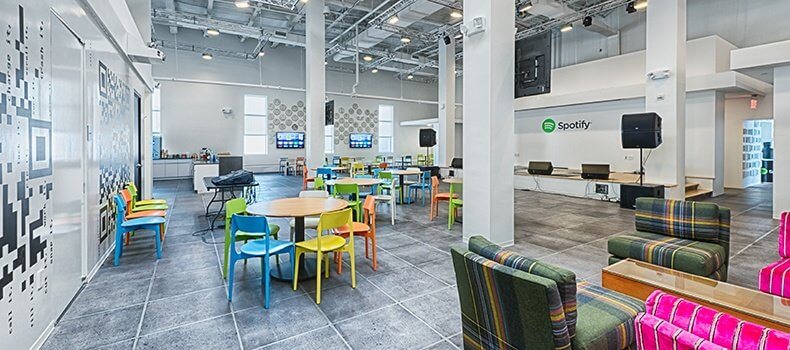Unleash Your Office Culture: The Value of Workplace Design

 What does your workspace say when you walk into it? What is the story you want to tell? For over 30 years, Bob Fox has been helping organizations move beyond the pragmatic of workplace design to a realize a much bigger opportunity – an opportunity to engage, inspire and attract their people.
What does your workspace say when you walk into it? What is the story you want to tell? For over 30 years, Bob Fox has been helping organizations move beyond the pragmatic of workplace design to a realize a much bigger opportunity – an opportunity to engage, inspire and attract their people.
Bob Fox, Founder and CEO of FOX Architects, and Founder and Publisher of Work Design Magazine has over 30 years of experience in the design of commercial office space working with tenants and landlords, with a focus on the design of high-quality corporate interiors.
Bob’s firm, FOX Architects is a fully integrated, award-winning architecture and interior design firm whose clients include many of America’s leading brands including Oracle, Visa International, Spotify, and Marriott.
Given his expertise in innovative design, we asked Bob about the top trends facilities managers should keep in mind when designing office environments.
BF: I think there is a huge shift to thinking about talent and attracting talent. I think as we go out to talk to people about their space the one thing we hear over and over again is that they are trying to attract and retain talent within their organizations. So, you are starting to see a lot more intangibles come into the workplace as a result of that. There is a growing importance to try to do more with the people issues, and those things are always kind of tough to measure for a facility manager because usually they are dealing with keeping track of all the space, the budget, the furniture and all those kinds of things.
Spotify HQ: Fox Design was able to provide Spotify with a space better suited to their forward-thinking culture and flexible work style.
With over three decades of experience in the design of commercial office space, we asked Bob what have been the biggest changes he has observed. The short answer? Everything.
BF: I think it is everything! If I look at it, when I got into the business it used to be how many offices do you need, how many workstations, how many conference rooms. It was really easy to do a test fit and lay that out. Today, I think that we have to have a much bigger and broader understanding of the culture of the organization, the type of work, how that work flows, the type of space is needed for that and the levels of support that are needed for that.
Bob tells us there are really no words to describe the changes we are seeing in workplace design today.
BF: If I just look at say collaborative space because it has been one of the drivers of a lot of the change. We are in this much more creative, knowledge worker, collaborative period of time right now – that’s how we add value to what we do. But when you use the word collaboration it’s become so generic as a word. We don’t have the vocabulary today with which to describe all the different ways in which we collaborate.
What is important to remember is the many, many ways in which we work, whether alone or in a group setting. Bob explains the need to have a deeper, richer understanding of how space is used in order to get the best performance from your people.
BF: If you think about a competing matrix where you have the 4 quadrants, on one end you can have the ‘private/quiet let’s sit here and concentrate and try to get this work done’ to the other end where it is a very open, public, highly-interactive collaborative space. And then you have the internal office type of space, and the other extreme of that would be out into a park or public area that you are doing all this work in. So you think of all the different ranges from being a private office to being an open collaborative area to something outside of the office at a cafe or coworking space, to where you can actually today sit in a park and get your work done.
So now we have to have a much deeper understanding of all those different types of space, and how they fit together, and what’s appropriate for your organization. Because we can put space together in a way that would really hinder the operation of that organization versus putting space together in a way that we really understand it, get the tools and the support and all the adjacencies right to really enhance the performance of that organization.

As Founder and Publisher of Work Design Magazine (WDM), a digital publication dedicated to exploring the ideas that are shaping the workplace, we asked Bob to tell us how he came to launch the site.
BF: I felt like there was a void in the industry, there were all these new alternative officing concepts that were being discussed but there was no place I could go really that I could meet with my peers and hash out these ideas and figure out what are the right solutions. I felt like there were so many people that were looking at it through different lenses and through different parts of it I was afraid we were confusing our clients more than helping them.
Bob tells us how WDM, which had started in the summer of 2010 as a research project by a group of his firm’s interns that morphed into a newsletter, had in its first month all of 200 readers. Today, the site has close to 30,000 visitors a month! We had to know if Bob had the vision to see what was a spontaneous project turn into the success it is today.
BF: No, I think all I was trying to do was start a conversation and say ‘hey how is everybody trying to handle this?’ and build a common language that we could use in the industry so that we weren’t confusing people and we were helping people realize a much better work environment. I think what’s most fun about it is I get to go out there now and have conversations with people I wouldn’t normally be interacting with so I get to see a lot more than I would ordinarily see. Having that opportunity to engage in those conversations is what’s been really meaningful to me.
Working across a variety of industries, the biggest challenge Bob sees frequently within organizations is a hyper focus on budgets and schedules. While budgets are important, we need to ask questions about the bigger picture and overall objectives.
BF: Budgets and schedules are important and I think any good designer is going to respect those budgets and schedules, but if you look beyond that budget to say ‘okay what do we really need to make this space special for this organization?’, ‘What do we really need to enhance the way that work flows through it?’ That’s not a budget or a schedule question. But I think too many times we see people saying ‘we have to keep the costs down’, or ‘we need it in a certain amount of time’ – because time is money and obviously the cost is money.
But if you are really looking to create value within an organization then you have to flip that upside down and say ‘how can we put our people together in a way that is going to really enhance that value and drive value?’ as opposed to hindering people where you are cutting costs. If you are squeezing them down too much at some point you are hindering their performance.

Getting people to see beyond the pragmatic and realize the potential of the environments organizations can create can be a stretch for a lot of people. We asked Bob for a tip for facilities managers to see more of that potential and vision in designing their workplace.
BF: I think if you look at the job description for most facilities managers it is about managing costs and schedules and keeping track of all the space and utilization of space. But a lot of times what’s left out of that job description is to just stop and try to envision what a great space would be. And what kind of space is really going to represent and be appropriate for that company? And what kind of space is going to reinforce the culture and tell the story behind that company? I think almost every designer out there is going to be responsible and respect the cost side of the equation. But let’s look at the potential is for what these spaces could be.
Try to think a little beyond the pragmatic. Engage people, surprise people, make the space a special place and really celebrate the people in the organization and look towards the value that the space can provide. It’s a tool and we can leverage that tool to build upon the value.
While being mindful of budgets and costs is critical in business, it is important to remember that there a point of diminishing returns in today’s modern workplace. When it comes to designing space for your people, don’t be afraid to think outside the box and imagine what could truly enable your space to fulfill it’s potential.




